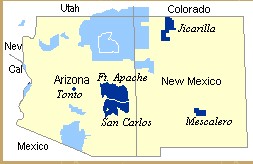
APACHE TRIBAL NATION

The word "apache" comes from the Yuma word for "fighting-men" and from the Zuni word meaning "enemy." The Apache tribe consists of six subtribes: the Western Apache, Chiricahua, Mescalero, Jicarilla, Lipan and Kiowa. Each subtribe is from a different geographial region. They are composed of six regional groups: Western Apache - Coyotero - most of eastern Arizona which include the White Mountain, Cibuecue, San Carlos, and Northern and Southern Tonto bands. It is possible, due to their nomadic nature, that several names were used to identify the same tribe. The Anglo theory is the Apache Indian migrated to the Southwest from Northern Canada in the 1500's. The Apache indian history says it was the other way around, that most of the Athapaskan speaking people migrated to the North and a few stayed in their homeland. In any event, it is generally agreed that about 5,000 Apaches lived in the Southwest at the end of the 1600's.
Apaches belong to the Southern Athapascan linguistic family.
The Apache tribe occupied the mountains and plains of southern Arizona and New Mexico, and also in Mexico.
The primitive dress of the men was deerskin shirt, leggings, and moccasins. They were never without a loin-cloth. A deerskin cap with attractive symbolic ornamentation was worn. The women wore short deerskin skirts and high boot top moccasins.
Chiricahua - southwestern New Mexico, southeastern Arizona, and adjacent Mexican states of Chihuahua and Sonora - The band was the informal political unit, consisting of followers and a headman. They had no formal leader such as a tribal chief, or council, nor a decision making process. The core of the band was a "relative group," predominantly, but not nessarily, kinsmen. Named by the Spanish for the mescal cactus the Apaches used for food, drink, and fiber. The basic shelter of the Chiricahua was the domeshaped wickiup made of brush. Similar the Navajo, they also regarded coyotes, insects, and birds as having been human beings; the human race, then, but following in the tracks of those who have gone before.
Mescalero - Faraon - live east of the Rio Grande in southern New Mexico, with the Pecos River as their eastern border
Jicarilla - Tinde - southeastern Colorado, northern New Mexico, and northwest Texas - During their zenith in the SouthWest, two divisions of the Jicarilla Apache were known: the Llanero, or "plains people," and the Hoyero, the "mountain people." They roamed from central and eastern Colorado into western Oklahoma, and as far south as Estancia, New Mexico. As a result of their eastern contacts, the Jicarilla adopted certain cultural traits of the Plains Indians, as did the Mescalero who also ranged the eastern plains. From an estimated population of 800 Jicarilla in 1845, the tribe today numbers about 1,800.
The Jicarilla (little basketmakers) are of the Athabascan language group and anthropologists say that these people came from Canada down the eastern flanks of the Rocky Mountains about 1300-1500 AD.
All tribes deny the migration theories and say that they have always been here:
The First People.
Though limited to using dogs as pack animals, the Jicarilla were the most successful raiders. When the Spaniards brought horses once again to North America (the previous horses had been eaten long before) the Jicarilla took full advantage.
They were not recognized as being distinctive from the other southern Athabascans: Chiricahuas, Navajos, Western Apaches, Mescaleros, Kiowa Apaches, and Lipans, until about 1700. Jicarilla are further identified as the plains people (Llaneros), and the mountain-valley people (Olleros) or Hoyero.
Their name for themselves is Tinde. But names that have been or are used by others than themselves are:
Mexican Spanish: Jicarilla, literally "little basket."
Navajo: Be'-xai, or Pex'-ge
Mescalero: Kinya-inde
Kiowa: Keop-tagui, "mountain Apache."
Picuris: Pi'-ke-e-wai-i-ne
Mescalero: Tashi'ne
Tesuque: Tu-sa-be'
Within the Jicarilla themselves are these smaller groups that claim certain areas as their original homes:
Dachizhozhin: site of the present Jicarilla Reservation.
Golkahin: south of Taos Pueblo.
Ketsilind: south of Taos Pueblo.
Apatsiltlizhihi: Mora .
Saitinde: around what is now Espanola.
Though all of these are in New Mexico, the Jicarilla have been all through parts of southeastern Colorado, northern New Mexico, and adjoining areas of Kansas, Oklahoma, and Texas.
Their contacts with the Spaniards began with Coronado in 1540 to 1542, perhaps as the Querechos, whom the later Spanish explorers called Vaqueros.
Hostilities began almost at first contact with the Spaniards, and though a Spanish mission was attempted near Taos in 1733, it was short-lived. Here is a general time table of the Jicarilla's relationships with the new landlords.
1853: A group of 250 Jicarilla were settled on the Puerco River, but a treaty with the governor of New Mexico was not honored by him and war broke out again.
1854: Jicarillas are defeated by the United States Army.
1870: The Jicarilla are living on the Maxwell grant in NE New Mexico, but it is sold out from under them.
1872 - 1873: The U.S. tries to move the Jicarilla to Fort Stanton.
1874: A reservation of 900 square mile is established at Tierra Amarilla, in the north of New Mexico Territory. This lasts less than four years.
1878: An Act of Congress is passed to force the Jicarilla south, they refuse, and their annuities are canceled. One version of history has called the resultant acts by the tribe as "resorting to thievery."
1880: Act of 1878 repealed, new reservation on the Navajo River.
1883: Jicarilla moved to Fort Stanton.
1887: On February 11, an Executive Order creates a reservation in the Tierra Amarilla area in northern New Mexico.
1908: A southern area is added to the reservation.
Lipan - occupy territory directly to the east of the Jicarilla
Kiowa - Gataka - long associated with the KIOWA, a Plains people, range over the southern plains of Colorado, Oklahoma, and Texas.
The Apache dwellings consisted of a dome shaped frame of cottonwood or other poles, thatched with grass. The house itself was termed, "Kowa" and the grass thatch, "Pi".
According to the Ndee from the beginning Is dzán naadleeshe', Changing Woman lived alone. One day she received inspiration to go up on a hill and build a wickiup with four poles, where the first rays of the sun would strike in the morning. Is dzán naadleeshe' went inside and lay there and as the sun came up, the sun shone between her legs. One of his rays went into her. This caused her first menstrual period. After that she became pregnant. She conceived a son and called him Nayé nazgháné; (Slayer of Monsters). Four days later she was impregnated by Water- Old Man and gave birth to Túbaadeschine (Born of the Water-Old Man). These were the first Apache people.
"The primitive Apache was a true nomad, a wandering child of Nature, whose birthright was a craving for the warpath with courage and endurance probably exceeded by no other people and with cunning beyond reckoning. Although his character is a strong mixture of courage and ferocity, the Apache is gentle and affectionate toward those with his own flesh and blood, particularly his children."
"They were always known as 'wild' Indians, and indeed their early warfare with all neighboring tribes as well as their recent persistent hostility toward our Government, which precipitated a 'war of extermination,' bear out the appropriateness of the designation."
The first intruders were the Spanish, who penetrated Apache territory in the late 1500s. The Spanish drive northward disrupted ancient Apache trade connections with neighboring tribes.
When New Mexico became a Spanish colony in 1598, hostilities increased between Spaniards and Apaches. An influx of Comanche into traditional Apache territory in the early 1700s forced the Lipan and other Apaches to move south of their main food source, the buffalo. These displaced Apaches began raiding for food.
Apache raids on settlers accompanied the American westward movement and the United States acquisition of New Mexico in 1848. The Native Americans and the United States military authorities engaged in fierce wars until all Apache tribes were eventually placed on reservations.
Most of the tribes were subdued by 1868, except for the Chiricahua, who continued their attacks until 1872, when their chief, Cochise, signed a treaty with the U.S. government and moved with his band to an Apache reservation in Arizona.
The last band of Apache raiders, led by the chief Geronimo, was hunted down in 1886 and was confined in Florida, Alabama, and finally Oklahoma Territory.
"The mescal harvest occurs in the season of new life and growth, when the call from the wild is strong in the blood, and like a class of children-for they are but grown-up children-they pour out into the wilds. From the camp where they have passed the winter they take to the trails which lead to the mescal hills."
FOOD
All Apache rely primarily on hunting of wild game and gathering of cactus fruits and other wild plant foods.
Hunting is a part of daily life - for food, clothing, shelter, blankets. Apache hunted deer, wild turkeys, jackrabbits, coyote, javelin, fox, beavers, buffalo, bears, mountain lions. There was no fishing. Eagles were hunted for their feathers. Two or three feathers were plucked from a bald eagle instead of being hunted for food.
Food was important to the Apache. Prairie dogs, snakes, turkeys, and fish in the Apache tribe were believed to be unclean so they didn't eat them. Apache boys were taught to move quickly and quietly through the forest to catch food for their family. Every Apache male hunted. The first thing an Apache male did before hunting was greased his body with animal fat to keep out the smell of a person and make the person smell like an animal so the animals wouldn't smell the person and run away.
They exchanged buffalo hides, tallow and meat, bones that could be worked into needles and scrapers for hides, and salt from the desert with the Pueblos for pottery, cotton, blankets, turquoise, corn and other goods. But at times they simply saw what they wanted and took it. They became known among the Pueblo villages by another name, Apachu, "the enemy".
RELIGION AND CEREMONIES:
The ceremonies are invariably called "dances." Among these are the rain dance, a puberty right, the sunrise dance for young women, a harvest and good crop dance, and a spirit dance. The Apache are devoutly religious and pray on many occasions and in various ways. Recreated in the human form, Apache spirits are supposed to dwell in a land of peace and plenty, where there is neither disease or death.
SONG OF APACHE INDIANS
HUH WUHLI NICH
Ha- nam-a yo- o ya hai huh-wurt . . .
far on the dessert redges stands the cactus
Ka- na - hu- va muh- muhk
lo the blossoms swaying
Ka- cho-wuch-chi ka-no- ya ki-moi
to and fro the blossoms swaying, swaying
SUNRISE DANCE: Women
From early spring to late fall, Apache girls reaching maturity are honored by their tribe with the Sunrise Dance. This ancient ritual is a test of a girl's endurance and discipline, and a celebration of her womanhood. The Sunrise Dance typically lasts four days. During this time, the girl being honored is dancing almost constantly, to the accompaniment of over 100 songs. Although she is assisted by her godparents and friends, it's a difficult task. Each stage of the ceremony is precisely choreographed, and the girl is not permitted to falter. Beverly Malone, a member of the White Mountain Apache Tribe, is with the Fort Apache Cultural Center in Arizona. She tells us about the teachings contained in the songs and the symbols of the ceremony.
"This particular dance teaches Apache values of language, culture, food and love, prayers, respect, wisdom, cooperation, appreciation and endurance."
The Indian dancers used ankle wraps to accompany their dances. There are bells atatched to a strap of leather. When you move your leg the ankle wrap rattles and jingles. They also placed these on their knees, elbows, or ankles.
For most of the four days and nights, to songs and prayers, they dance, as well as run toward the four directions. During this time, they also participate in and conduct sacred rituals, receiving and giving both gifts and blessings, and experiencing their own capacity to heal.
In the early 1900s, when the U.S. government banned Native American spiritual practices and rituals, conducting the Sunrise Ceremony was an illegal act; as a result, its practice diminished, and those ceremonies that did occur were conducted secretly.
Women play a vital role in Apache culture, and the Sunrise Dance is a way for the entire community to recognize and celebrate the meaning and value of womanhood.
"Usually the women are the main ones that are the teachers, and they are the stronghold for the family. The children claim their mom's side of the clan, and the father's clan is just like the distant family clan. It's the woman that holds the family together -- that's the boss in the family."
The Apaches were hunter, farmers and seed gatherers. They knew every land feature in the plains. Apache women built irrigation ditches and planted corn. The crops were not very good, so hunters searched the land for deers, gophers, wild turkeys and lizards. The women gathered cactus fruit and acorns. The Apache loved raiding and warfare, and boys were trained for warfare since they were born. They could walk for miles without any food or water . They learned to hunt, stand guard, keep silent,and send and read smoke signals. When the boys were 15 years old they were ready to go to war. Young girls were trained by their mothers to do the household chores. The girls married very young. The daughters husband was not aloud to talk or see their mother-in-law.
Not until 1978, when the American Indian Religious Freedom Act was passed, was the Sunrise Ceremony openly re-established on most reservations. But even today, because of the expense and time involved - which also includes four days of preparation and four days of teaching and recovery - some girls celebrate for one or two days, rather than have four day ceremonies. The families of girls entering puberty in a particular year may also sponsor joint Sunrise ceremonies, in which two or more newly menstruating girls celebrate the rites of Changing Women together.
Apache Girls' Puberty Ceremony
-- Anna Goseyun
http://nativenet.uthscsa.edu/archive/nl/9207/0062.html
Nja
Njeesh: She Is Painted Image (from Fort Apache)
http://www.geocities.com/Athens/Delphi/2897/
Puberty
Ceremony Girls Image (Apache Pass Web Site)
http://members.aol.com/apachepass/index4.html
Changing Woman Myth
Changing Woman
APACHE SYMBOLS
The importance of the circle is depicted by the shape of the four sacred hoop symbols. The shape of many traditional homes is round, such as the Apache wickiup, the Navajo hogan, and the tipi of the Lakota. Religious ceremonies are performed in circular structures, such as in the hogan and the tipi. Traditional dances are also performed in a circle. The motion of the sun, moon, and stars across the sky is circular. The life paths of all creatures, including humans, are also circular.
Apache Hoop---Dee´ (San Carlos Apache) and Ndee´ (White Mountain Apache)
The Apache hoop is used in traditional ceremonies and the type of ceremony determines whether a single hoop or four hoops are used. The hoop represents the cycle of life from birth to death. It possesses special powers, which could be used, for example, to bless an individual when the hoop completely encircles the body. The hoop also has healing and protective powers.
The single Apache hoop has one of the four sacred colors of the tribe: black, green, (blue), yellow and white. These colors represent the four directions, the four seasons, and the four major divisions of the day. An eagle feather is tied at four locations on the hoop. To the Apache, and almost all tribes, the eagle is a sacred bird and its feathers are believed to have special powers.
The basket symbolizes one’s realm of existence with the center opening representing one’s birth into this world and the various designs representing the plains and sacred mountains among which one dwells.
The Apaches are commonly known for their incredible endurance and warfare skills. First arriving in the Southwest sometime between A.D.1000 and 1400, the Apaches carved out a home on the south side of the Rocky mountains. As early as 1540, the Apaches confronted Coronado in eastern New Mexico and were called "vaqueros." By the 1600's, they were also living in Arizona. Between 1656 and 1675, the Apaches continuously raided Spanish Settlers and Pueblo Indians in what is now known as New Mexico. In 1680, their population was approximately 5000. In 1692, the Spaniards reconquered New Mexico and the Apaches were starting to make enemies.
Cochise ( Hardwood )
( Tribe : Chiricahua Apache )
c.1815-1874, chief of the Chiricahua APACHE in Arizona, noted for courage, integrity, and military skill. From 1861, when soldiers unjustly hanged some of his relatives, he warred relentlessly against the U.S. army. Peace talks in 1872 promised him a reservation on his native territory, but after he died his people were removed.
Cochise was a tall man, six feet, with broad shoulders and a commanding appearance. He never met a man his equal with a lance, and, like Crazy Horse, was never photographed. They both were buried in secret locations on their homeland.
Cochise angered by the murder of his Father-in-law, Mangas Coloradas went of a war spree.
The Cochise Stronghold, nestled in the Dragoon's canyons, was their impregnable fortress for many years. Cochise eventually signed the Broken Arrow Peace Treaty at a prominent area landmark, Council Rock. His son Naiche signaled the signing with a white flag from atop Treaty Hill.
Cochise died in 1874 of natural causes. His body was dress in his best war garments. He was decorated in war paint, and head feathers. His body was then wrapped in a brillant red blanket, and place on his horse. The horse was guided to a remote place in the Dragoons. The horse was shot and lowered into the chasm along with Cochise's gun and other arms. Lastly Cochise was lowered into the rocky cavern by lariots. The location of this burial site remains a mystery to this day.
Apache in a nine-day battle forced the Apache to move farther south. The most famous battles with the Apache happened between 1862 and 1873 when the Apache fought a bloody war against the confederate and U.S. armies. In 1873 a peace treaty was signed and the U.S. government wanted to move the Apaches to reservations. Some Apaches went peacefully but others did not.
Small factions broke out with leaders like Geronimo,Naiche and Victorio. In 1886, Geronimo and his followers were finally taken into captivity and most of the Apache renegades were moved to Fort Sill, Oklahoma where they were considered prisoners of war until 1913. Today there are over 40,000 Apaches living in reservations
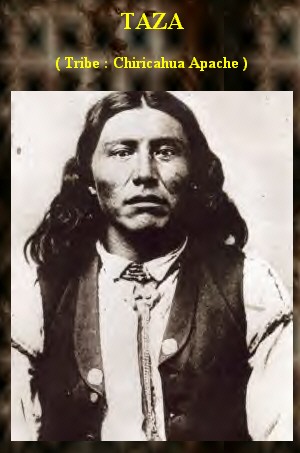
c. 1835-1876. As the first son of COCHISE, Taza became the leader of his father's group when Cochise died in 1874. Taza, who was also brother of NAICHE and grandson of MANGAS COLORADAS, strove to honor his father's peace agreement with the army. In 1876, he agreed to relocate his people from the Chiricahua Reservation at Apache Pass, Arizona, to the San Carlos Reservation. However, he could not unite the various Apache bands under his leadership as Cochise had done. Consequently, GERONIMO and his followers crossed the Mexican border into the Sierra Madre of Mexico. This remote area became their base camp. In the summer of 1876, Taza joined the Apache delegation to Washington, D.C., to sue for peace. During this trip, Taza succumbed to pneumonia and was buried in the Congressional Cemetery. As a result of Taza's death, Naiche became more militant.

Geronimo {jur-ahn'-i-moh}, or Goyathlay ("one who yawns"), was born in 1829 in what is today western New Mexico, but was then still Mexican territory. He was a Bedonkohe Apache (grandson of Mahko) by birth and a Net'na during his youth and early manhood. His wife, Juh, Geronimo's cousin Ishton, and Asa Daklugie were members of the Nednhi band of the Chiricahua Apache. He was reportedly given the name Geronimo by Mexican soldiers, although few agree as to why. As leader of the Apaches at Arispe in Sonora, he performed such daring feats that the Mexicans singled him out with the sobriquet Geronimo (Spanish for "Jerome"). Some attributed his numerous raiding successes to powers conferred by supernatural beings, including a reputed invulnerability to bullets. Geronimo's war career was linked with that of his brother-in-law, Juh, a Chiricahua chief. Although he was not a hereditary leader, Geronimo appeared so to outsiders because he often acted as spokesman for Juh, who had a speech impediment. Geronimo was the leader of the last American Indian fighting force formally to capitulate to the United States. Because he fought against such daunting odds and held out the longest, he became the most famous Apache of all. To the pioneers and settlers of Arizona and New Mexico, he was a bloody-handed murderer and this image endured until the second half of this cent To the Apaches, Geronimo embodied the very essence of the Apache values, agressiveness, courage in the face of difficulty. These qualities inspired fear in the settlers of Arizona and New Mexico. The Chiricahuas were mostly migratory following the seasons, hunting and farming. When food was scarce, it was the custom to raid neighboring tribes. Raids and vengeance were an honorable way of life among the tribes of this region. By the time American settlers began arriving in the area, the Spanish had become entrenched in the area. They were always looking for Indian slaves and Christian converts. One of the most pivotal moments in Geronimo's life was in 1858 when he returned home from a trading excursion into Mexico. He found his wife, his mother and his three young children murdered by Spanish troops from Mexico. This reportedly caused him to have such a hatred of the whites that he vowed to kill as many as he could. From that day on he took every opportunity he could to terrorize Mexican settlements and soon after this incident he received his power, which came to him in visions. Geronimo was never a chief, but a medicine man, a seer and a spiritual and intellectual leader both in and out of battle. The Apache chiefs depended on his wisdom. When the Chiricahua were forcibly removed (1876) to arid land at San Carlos, in eastern Arizona, Geronimo fled with a band of followers into Mexico. He was soon arrested and returned to the new reservation. For the remainder of the 1870s, he and Juh led a quiet life on the reservation, but with the slaying of an Apache prophet in 1881, they returned to full-time activities from a secret camp in the Sierra Madre Mountains. In 1875 all Apaches west of the Rio Grande were ordered to the San Carlos Reservation. Geronimo escaped from the reservation three times and although he surrendered, he always managed to avoid capture. In 1876, the U.S. Army tried to move the Chiricahuas onto a reservation, but Geronimo fled to Mexico eluding the troops for over a decade. Sensationalized press reports exaggerated Geronimo's activities, making him the most feared and infamous Apache. The last few months of the campaign required over 5,000 soldiers, one-quarter of the entire Army, and 500 scouts, and perhaps up to 3,000 Mexican soldiers to track down Geronimo and his band. In May 1882, Apache scouts working for the U.S. army surprised Geronimo in his mountain sanctuary, and he agreed to return with his people to the reservation. After a year of farming, the sudden arrest and imprisonment of the Apache warrior Ka-ya-ten-nae, together with rumors of impending trials and hangings, prompted Geronimo to flee on May 17, 1885, with 35 warriors and 109 women, children and youths. In January 1886, Apache scouts penetrated Juh's seemingly impregnable hideout. This action induced Geronimo to surrender (Mar. 25, 1886) to Gen. George CROOK. Geronimo later fled but finally surrendered to Gen. Nelson MILES on Sept. 4, 1886. The government breached its agreement and transported Geronimo and nearly 450 Apache men, women, and children to Florida for confinement in Forts Marion and Pickens. In 1894 they were removed to Fort Sill in Oklahoma. Geronimo became a rancher, appeared (1904) at the Louisiana Purchase Exposition in St. Louis, sold Geronimo souvenirs, and rode in President Theodore Roosevelt's 1905 inaugural parade. Geronimo's final surrender in 1886 was the last significant Indian guerrilla action in the United States. At the end, his group consisted of only 16 warriors, 12 women, and 6 children. Upon their surrender, Geronimo and over 300 of his fellow Chiricahuas were shipped to Fort Marion, Florida. One year later many of them were relocated to the Mt. Vernon barracks in Alabama, where about one quarter died from tuberculosis and other diseases. Geronimo died on Feb. 17, 1909, a prisoner of war, unable to return to his homeland.
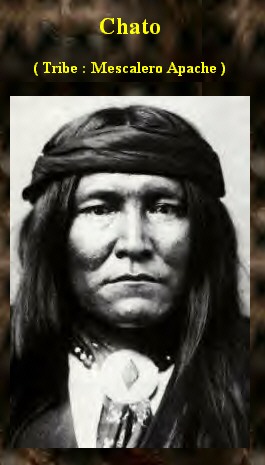
Chato was one of Cochise’s twelve captains who met General Howard at the Treaty of Dragoon Springs. After the treaty was broken by the politicians, Chato joined the U.S. Army as a scout. He helped to bring his own people to subjugation, always believing the promise that they would be accorded the same rights and treatment as other Americans. Because of his valor he was called to Washington to receive a medal from the President. It was he, Chato, that whirlwind of destructiveness and ferocity, commanding 200 Apache scouts under General Crook who brought the rapacious career of Geronimo to an end. Of the surrender of Geronimo, General Crook said, "The surrender of Geronimo could not have been effected except for the assistance of Chato and his scouts. For their allegiance, they have been rewarded by captivity in a strange land." Of the medal given him by President Grover Cleveland, Chato said, "Why was I given a medal to wear in the guardhouse?" And that is where Chato spent the next twenty-seven years of his life, for on his return from Washington by train, he was arrested along with all Chiricahuas, by the Army. He remained a prisoner of the U.S. Army for longer than any prisoner in U.S. Army history. Political policy had changed suddenly in Washington and the bemedaled hero became a prisoner. Coming home one dark, cold night from the town of White Tail, New Mexico, Chato’s Model-T ran off the steep mountain road. The eighty year old warrior died in an icy stream. He was mourned throughout Otero County, New Mexico and in the Mescalero Reservation.
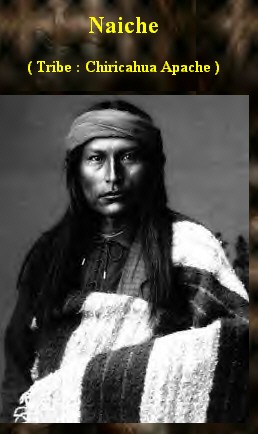
c.1857-1921. As a young man, Naiche (means "the Mischief Maker" or "Meddlesome One") led many raids against white settlers. When his older brother TAZA died of pneumonia in 1876m he became chief of the Chiricahua Apaches. In 1879, Naiche resisted relocation to the San Carlos Apache Reservation and went to Mexico with GERONIMO's Band. While ensconced in the Sierra Madre south of Rio Grande, Naiche and Geronimo attacked American and Mexican communities with relative impunity. While Naiche was certainly the hereditary chief of the Chiricahua Apaches at this time, it appears that Geronimo was viewed as the great leader and probably persuaded Naiche, the younger man, to submit to his leadership during these campaigns. During the early 180s, the U.S. Army relentlessly tracked the rebellious Chiricahua Apaches until Naiche surrendered on May 25,1883, to General George Crook. For a while, Naiche and Geronimo languished at the San Carlos Reservation, but in 1885, the two leaders left with over one hundred men in a last attempt to avoid American control. By September 1886, Apache scouts and detachments of the U.S. Army were able to force their surrender in the inhospitable terrain of Mexico. Soon after the Chiricahuas were captured, Naiche and Geronimo and their men were incarcerated first at Fort Marion, Florida, and then at Mount Vernon Barracks in Alberta. Although Naiche and his men wanted return home to Arizona, angry white settlers there prevented it. After Kiowa and Comanche leaders invited the Chiricahua Apaches to share their reservation, Naiche and 295 other Apaches relocated to Fort Sill, Oklahoma, on October 4, 1895. Naiche remained in Oklahoma until 1913. He eventually returned to the Southwest, where he lived in peace for eight years, dying of influenza at Mescalero, New Mexico, in 1921.
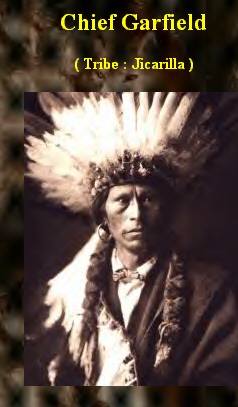
GARFIELD - JICARILLA - APACHE
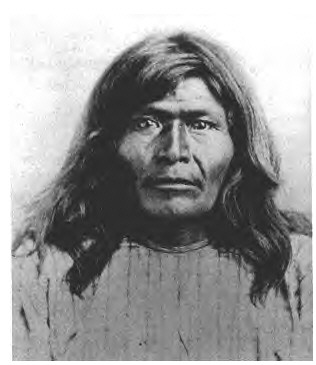
Victorio was a skilled strategist, known for his bravery. He and his men battled both the Mexicans and the Americans from 1863 to 1877. In 1877 Victorio signed a peace treaty on behalf of the Apache. When the U.S. unilaterally broke the treaty after just four months, Victorio and his men kept on raiding, hiding in the mountains to survive. Over the next couple of years Victorio signed more treaties, was captured, was indicted, and always managed to escape. In 1880 his band was cornered, and in a two-day battle most of them were wiped out. It is unclear whether Victorio was killed in battle or took his own life as the army closed in on him. The Apache and their foes respected and admired Victorio for his bravery and tenacity against incredible odds.
Gouyen
Gouyen, meaning "Wise Woman," was born into Chief Victorio's Warm Springs Apache band around 1880. One day, while the group was resting at Tres Castillos, New Mexico, it was attacked by Mexicans. When the offensive was over, seventy-eight Apaches had been murdered and only seventeen had escaped, including Gouyen and her young son, Kaywaykla. Her baby daughter, however, was murdered and shortly afterwards her husband was killed in a Comanche raid while visiting the Mescalero Apaches.
A legendary tale is told about the revenge of Gouyen. One night following her husband's death, she put on her buckskin puberty ceremony dress and left the camp carrying a water jug, dried meat, and a bone awl and sinew for repairing her moccasins. She was looking for the Comanche chief who had killed her husband. Finally, she found him engaged in a Victory Dance around a bonfire with her husband's scalp hanging from his belt. Gouyen slipped into the circle of dancers, seduced the chief, and killed him, avenging her husband's death. Then she scalped him, cut his beaded breechcloth from his body and tore off his moccasins. She then returned to her camp to present her in-laws with the Comanche leader's scalp, his clothing and his footwear.
Gouyen remarried an Apache warrior named Ka-ya-ten-nae. Later, she and her family were taken prisoner by the U.S. Army and held at Fort Sill, Oklahoma, where she died./
Lozen
Lozen was born into the Chihenne, Warm Springs Apache band, during the late 1840's. She was the sister of Chief Victorio and a skillful warrior, a prophet, and an outstanding medicine woman. Victorio is quoted as saying, "Lozen is my right hand . . . strong as a man , braver than most, and cunning in strategy, Lozen is a shield to her people."
Legend has it that Lozen was able to use her powers in battle to learn the movements of the enemy and that she helped each band that she accompanied to successfully avoid capture. After Victorio's death, Lozen continued to ride with Chief Nana, and eventually joined forces with Geronimo's band, eluding capture until she finally surrendered with this last group of free Apaches in 1886. She died of tuberculosis at the Mount Vernon Barracks in Mobile, Alabama
White Mountain Apache Tribe is located in the east central region of Arizona, 194 miles northeast of Phoenix. Located on the Apache, Gila and Navajo Counties, the White Mountain Apaches reside on 1.6 million acres at its ancestral homeland on the Fort Apache Indian Reservation.
On November 9, 1891, by Executive Order the Fort Apache Indian Reservation was established. It is now known as the White Mountain Apache Reservation. It originally included the San Carlos Apache Reservation but was separated by an act of Congress in 1897.
The White Mountain Apache are the direct descendants of the original tribes that lived in this area. The people were once nomadic, however, they now occupy permanent dwellings and depend on livestock, agriculture, tourism and various tribal enterprises for their livelihood.
White Mountain Apaches hold dearly to their traditions--from their strong beliefs, the long free-handing shirt (adopted in 1870), to the Crown Dance and basketry.
The Tribe has over 12,000 members located on nine major reservation communities. Whiteriver, the capital, is the largest community with over 2,500 residents. The topography ranges from 11,000 feet to 3, 000 feet at the Salt River Canyon with its Pre-Cambrian history
Apache Links:
Apache from Encarta
APACHE INDIANS info and links
THE SAN CARLOS APACHE PEOPLE etails and links
Fort Apache Reservation you must have "Acrobat" to access this well done site
Fort Apache Indian Reservation info on this place & the author's views, too
Fort McDowell Mohave-Apache Reservation another "Acrobat" based page
Apache info on them & bios on a few leaders
Apache basic info & some links
Jicarilla Apache: Tinde lots of info
The Jicarilla from ES Curtis
Apache by ES Curtis
Apache a general history
Arizona Apache Wars a very detailed site with pictures
Apache article on Human Remains
Apache Indians by Helena a Third Grader at John F. Pattie Elementary School
Apache Indians from the excellent Handbook of Texas Online
Tucabante Indians The Tucubante Indians are a part of the Apaches
Apacheria "used to designate the area inhabited by the Apache Indians"
Conejero Indians "a Plains Apache band"
Rio Colorado Indians basic info on this band
Trementina Indians "an early Lipan Apache group"
Salinero Indians "among the groups that eventually became known as Mescalero Apaches"
The battle of Tinaja de las Palmas about this fight
Limita Indians "One of many Plains Apache groups"
Chenti Indians basic info
The Yxandi (Sandi, Ysandi) Indians basic info on this band
Manso Indians "(Maise, Mansa, Manse, Manxo) Indians, also known as Gorreta"
Vaquero Indians "generally believed that the Vaqueros were ancestral to the Apaches"
Melenudo Indians appear to have been a band of Lipan Apache
Teya Indians "Most writers...identify them as Plains Apaches"
Apache Indian History very detailed site
Apache Tribe of Oklahoma Vocational Rehabilitation Program Web Site
Apache Life games, religion, hunting
Apache Quotes LOTS of them!
Jicarilla Apache Tribe basic info
Apache basic info and pictures
Jicarilla Museum basic info
Mescalero Dump Blocked... and Reborn about nuclear waste
Mescalero Apache Tribe basic info
Men's Work growing up
Apache Men several biographies
Na'ii'ees The Apache Woman's Puberty Ceremony
Apache Native Americans from DesertUSA
Jicarilla Indians expand their reservation from the High Country News
BUFFALO SOLDIERS AND MESCALERO APACHES IN THE GUADALUPES article about this event
Shamanism and Peyote Use Among the Apaches of the Mescalero Indian Reservation detailed artice
Mezcaleros- Makers of Mezcal about this association
Chiricahua Apaches a few pages and pictures
Apache Women bios on Maa-ya-ha (Grandmother Nellie), Gouyen and Lozen
Old Apache Customs notes from a scholarly work
Apache from emayzine
BUFFALO SOLDIERS AND MESCALERO APACHES IN THE GUADALUPES By Lynn Chelewski
Jicarilla Apache: Tinde good basic info
Jicarilla Apache Tribe short page from Bluebook
Mescalero Apache Tribe short page from Bluebook
Apaches short page from "Texas Cultures"
Related Apache Links
APACHE CULTURE
An Apache Medicine Dance
Apache Literature
APACHE GENERAL:
Curtis Collection: On Apaches
APACHE TRIBES
Fort Apache/White Mountain
Jicarilla Apaches
BOOKS: Apache
Apache, the Sacred Path Womanhood